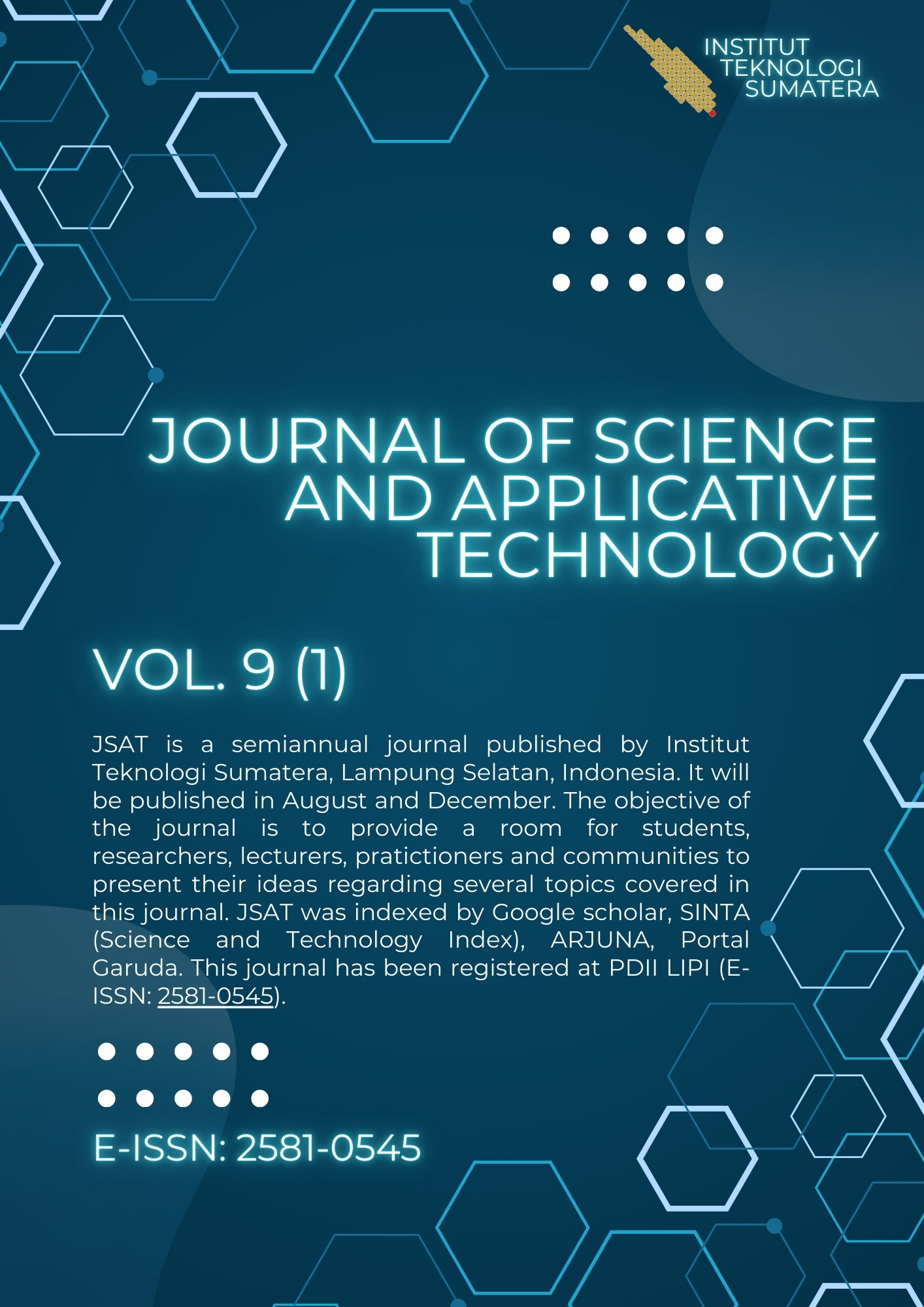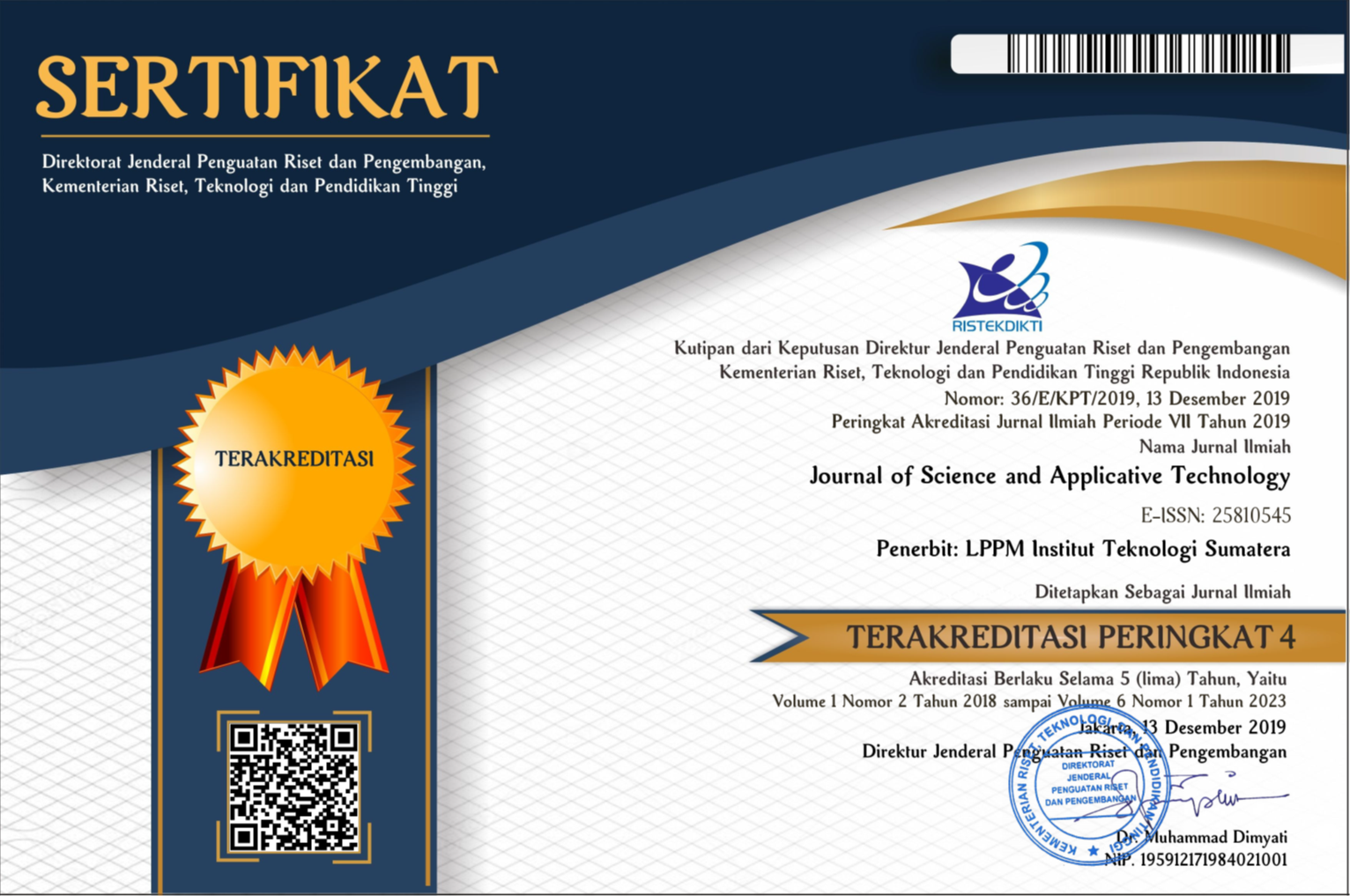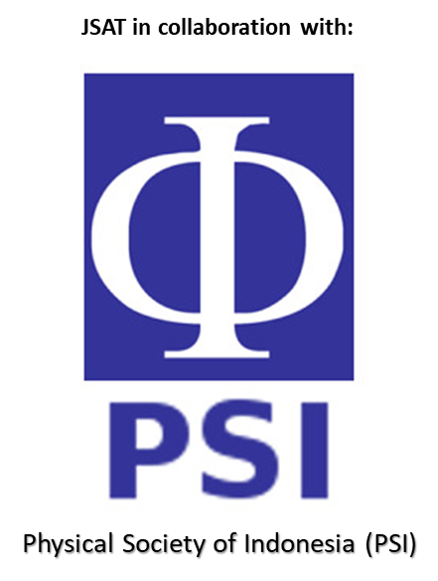Statistical Pattern Recognition of Lithosphere Anomalous Activity Along the Indonesian Ring of Fire
Abstract
The introduction of statistical pattern recognition becomes highly important for assessing disaster threats such as earthquakes. This approach is significantly more comprehensive and suitable for long-term event forecasting. Therefore, in the future, efforts can be promptly made to reduce the risk of disasters resulting from anomalies in lithospheric activity, especially frequent earthquakes in the Sumatra Island region, Indonesia. Statistical pattern analysis of lithospheric activity anomalies can be categorized through classification. Earthquake classification is performed based on magnitude scale and mathematical calculations of earthquake parameter unit conversion. The classification method employed in this research includes machine learning methods like k-nearest neighbor and support vector machine. The evaluation metrics used for machine learning models are model accuracy and confusion matrix tables.
Downloads
References
[2] Hall, R., 2017. Southeast Asia: New views of the geology of the Malay Archipelago. Annual Review of Earth and Planetary Sciences, 45, pp.331-358.
[3] Sharma, R., Sinha, A. and Kautish, P., 2020. Examining the impacts of economic and demographic aspects on the ecological footprint in South and Southeast Asian countries. Environmental Science and Pollution Research, 27, pp.36970-36982.
[4] Fabinyi, M., Belton, B., Dressler, W.H., Knudsen, M., Adhuri, D.S., Aziz, A.A., Akber, M.A., Kittitornkool, J., Kongkaew, C., Marschke, M. and Pido, M., 2022. Coastal transitions: Small-scale fisheries, livelihoods, and maritime zone developments in Southeast Asia. Journal of Rural Studies, 91, pp.184-194.
[5] Jamil, F. Mukhaiyar, R. Dan Husnaini. (2020) “Kajian Literatur Rekonstruksi Mata Kuliah (Studi Kasus Mata Kuliah Pengolahan Sinyal Teknik Elektro URIP),”Jurnal Teknik Elektro Danvokasional, 6(2).
[6] Lorito, S., Romano, F. and Lay, T., 2022. Tsunamigenic major and great earthquakes (2004–2013): source processes inverted from seismic, geodetic, and sea-level data. Complexity in Tsunamis, Volcanoes, and their Hazards, pp.247-298.
[7] D'Arrigo, R., Carslaw, K.S., Zhu, T., Dessler, A.E., Forster, P. and Polvani, L.M., 2019, December. Northern Hemisphere wintertime continental warming following large, low-latitude volcanic eruptions? No evidence from Pinatubo (1991) and Krakatau (1883). In AGU Fall Meeting Abstracts (Vol. 2019, pp. A21B-01).
[8] Dumont, S., Custódio, S., Petrosino, S., Thomas, A.M. and Sottili, G., 2023. Tides, earthquakes, and volcanic eruptions. A Journey Through Tides, pp.333-364.
[9] Webb, A. R. (2003). Statistical pattern recognition. John Wiley & Sons.
[10] Brancato, A., Buscema, P. M., Massini, G., & Gresta, S. (2016). Pattern recognition for flank eruption forecasting: an application at Mount Etna volcano (Sicily, Italy). Open Journal of Geology.
[11] Sandri, L., Marzocchi, W., & Gasperini, P. (2005). Some insights on the occurrence of recent volcanic eruptions of Mount Etna volcano (Sicily, Italy). Geophysical Journal International, 163(3), 1203-1218.
[12] Curilem, M., Vergara, J., San Martin, C., Fuentealba, G., Cardona, C., Huenupan, F., & Yoma, N. B. (2014). Pattern recognition applied to seismic signals of the Llaima volcano (Chile): An analysis of the events' features. Journal of Volcanology and Geothermal Research, 282, 134-147
[13] San-Martin, C., Melgarejo, C., Gallegos, C., Soto, G., Curilem, M., & Fuentealba, G. (2010). Feature extraction using circular statistics applied to volcano monitoring. In Progress in Pattern Recognition, Image Analysis, Computer Vision, and Applications: 15th Iberoamerican Congress on Pattern Recognition, CIARP 2010, Sao Paulo, Brazil, November 8-11, 2010. Proceedings 15 (pp. 458-466). Springer Berlin Heidelberg.
[14] Novelo-Casanova, D. A., & Valdes-Gonzalez, C. (2008). Seismic pattern recognition techniques to predict large eruptions at the Popocatépetl, Mexico, volcano. Journal of Volcanology and Geothermal Research, 176(4), 583-590.)
[15] Burl, M. C., Fayyad, U. M., Perona, P., Smyth, P., & Burl, M. P. (1994). Automating the hunt for volcanoes on Venus.
[16] Ida, Y., Fujita, E., & Hirose, T. (2022). Classification of volcano-seismic events using waveforms in the method of k-means clustering and dynamic time warping. Journal of Volcanology and Geothermal Research, 429, 107616.
[17] Di Giuseppe, M. G., Troiano, A., Patella, D., Piochi, M., & Carlino, S. (2018). A geophysical k-means cluster analysis of the Solfatara-Pisciarelli volcano-geothermal system, Campi Flegrei (Naples, Italy). Journal of Applied Geophysics, 156, 44-54.
[18] Corradino, C., Amato, E., Torrisi, F., Calvari, S., & Del Negro, C. (2021). Classifying major explosions and paroxysms at Stromboli volcano (Italy) from space. Remote Sensing, 13(20), 4080
[19] Novianti, P., Setyorini, D., & Rafflesia, U. (2017). K-Means cluster analysis in earthquake epicenter clustering. International Journal of Advances in Intelligent Informatics, 3(2), 81-89.
[20] Rydelek, P. A., Davis, P. M., & Koyanagi, R. Y. (1988). Tidal triggering of earthquake swarms at Kilauea volcano, Hawaii. Journal of Geophysical Research: Solid Earth, 93(B5), 4401-4411.
[21] Petrosino, S., Cusano, P., & Madonia, P. (2018). Tidal and hydrological periodicities of seismicity reveal new risk scenarios at Campi Flegrei caldera. Scientific reports, 8(1),1-12.
Copyright (c) 2025 Journal of Science and Applicative Technology

This work is licensed under a Creative Commons Attribution-NonCommercial 4.0 International License.
All the content on Journal of Science and Applicative Technology (JSAT) may be used under the terms of the Creative Commons Attribution-NonCommercial 4.0 International License.
You are free to:
- Share - copy and redistribute the material in any medium or format
- Adapt - remix, transform, and build upon the material
Under the following terms:
- Attribution - You must give appropriate credit, provide a link to the license, and indicate if changes were made. You may do so in any reasonable manner, but not in any way that suggests the licensor endorses you or your use.
- NonCommercial - You may not use the material for commercial purposes.
- No additional restrictions - You may not apply legal terms or technological measures that legally restrict others from doing anything the license permits.





















